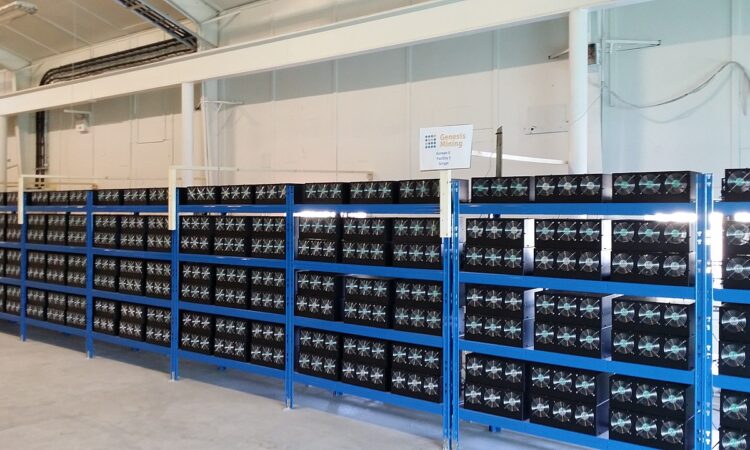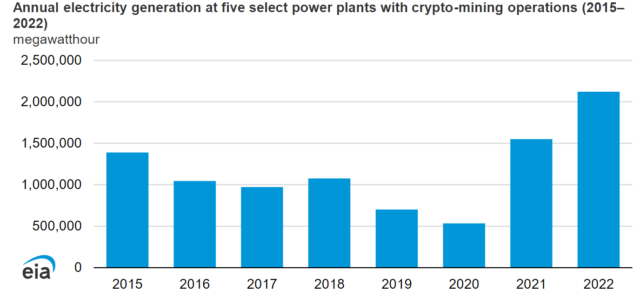
In response to the rapid growth of cryptocurrency mining operations in the United States and the associated surge in electricity demand, the U.S. Energy Data Agency (EIA) announced plans to closely monitor the energy consumption of these activities. This decision comes amidst increasing concerns among policymakers and grid planners regarding the potential impact of cryptocurrency mining on the nation’s electricity grid, cost, and emissions.
Cryptocurrency mining, the process of validating transactions and adding them to a blockchain ledger, requires significant computational power, resulting in substantial energy consumption. In recent years, the expansion of cryptocurrency mining activities in the US has been particularly noteworthy, fueled partly by the relocation of operations from China following regulatory crackdowns.
One of the primary challenges in assessing cryptocurrency mining energy consumption accurately is the diverse nature of mining facilities and their mobility. Cryptocurrency mining operations can vary widely in scale, from small-scale setups to large data centers. This diversity makes it challenging to identify and track them among millions of end-use customers. Unlike traditional industrial consumers of electricity, cryptocurrency mining operations present unique tracking challenges due to their dynamic nature.
Additionally, the dynamic nature of the crypto market complicates efforts to estimate energy consumption accurately. Mining assets can be rapidly moved to areas with lower electricity prices, adding to the challenge. However, despite these challenges, the EIA is committed to developing comprehensive estimates of electricity use by cryptocurrency miners. They plan to employ a combination of top-down and bottom-up approaches to achieve this goal.

Data source: U.S. Energy Information Administration
Institutional response and data collection
To facilitate this data collection effort, the EIA has obtained emergency clearance from the Office of Management and Budget (OMB) to collect monthly data on cryptocurrency mining energy use from February to July 2024. This initiative underscores the agency’s proactive stance in addressing the evolving energy landscape shaped by emerging technologies like cryptocurrencies.
The EIA’s data collection efforts will involve collaboration with industry stakeholders, including cryptocurrency mining firms. Additionally, the agency will leverage existing resources such as the Cambridge Bitcoin Electricity Consumption Index (CBECI). This index provides estimates of power demand from operations mining for Bitcoin and Ethereum on a daily and annual basis. It offers valuable insights into global and US-based cryptocurrency mining activities.
Read more: New Found Gold intercepts high grade gold assays in Newfoundland
Read more: Galan Lithium secures C$15.9M to develop Argentina brine project
Data source: U.S. Energy Information Administration
Addressing concerns and ensuring transparency
The decision to monitor cryptocurrency mining energy consumption aligns with growing concerns among policymakers and grid planners. They are concerned about the potential implications of this energy-intensive activity. Issues such as strains on electricity grids during peak demand periods, potential increases in electricity prices, and environmental impacts have prompted calls for greater transparency and accountability. These calls specifically target the crypto mining sector.
By tracking and analyzing energy consumption data, the EIA aims to provide policymakers, energy planners, and the general public with comprehensive insights into cryptocurrency mining operations’ energy use. This information will be crucial for informed decision-making and policy formulation. It is aimed at ensuring the sustainability and resilience of the nation’s energy infrastructure amidst evolving technological trends.
As crypto mining continues to evolve, the EIA’s proactive efforts to monitor energy consumption represent a crucial step. These efforts aim to address the challenges and potential risks associated with this rapidly growing industry. By leveraging data-driven insights, stakeholders can work towards a more sustainable and resilient energy future. This approach allows for harnessing the benefits of emerging technologies while mitigating potential negative impacts.
zartasha@mugglehead.com






